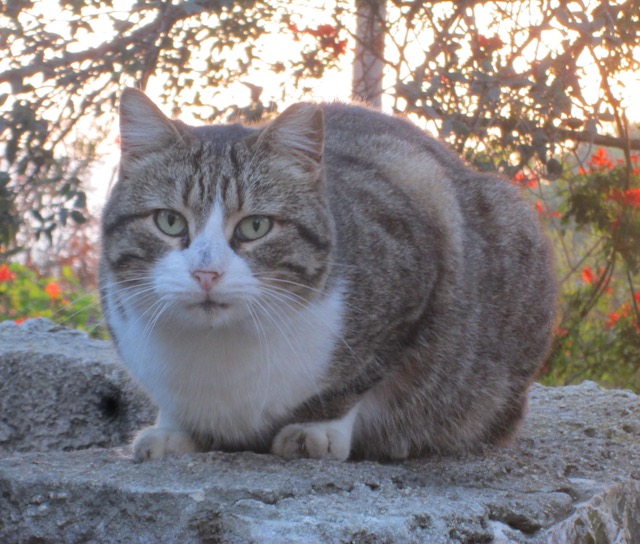 |
Jerusalem cats are not for the most part kept in private, they are community pets, shared by whole neighborhoods. There are people who feed them leaving food for them all over the place, and then there are people who are strongly against feeding them. It’s a similar case in Istanbul, except there there seems to be a consensus that cats are to be loved (unless, of course, they are caught stealing). But comparison may not be entirely fair, since Istanbul is next to the water, with many fish restaurants, and as we know There is no sea in Jerusalem.*
(*It sounds better in Hebrew, Ain yam b'Yerushalayim.)
The term feral cats has a frightful ring, but not all the outdoor cats are all that wild, and many will, if approached with good intentions (yes, they can read you!), purr as you stroke their fur. This has beneficial results for both humans and felines for reasons that aren’t entirely clear. They will, if drawn by a tempting aroma, jump into trash containers, and I suppose this is one reason some people treat them with such disdain.
Once I was walking near Nahalat Shiv’a neighborhood and noticed a stencil graffiti on an otherwise bare cement wall. I found it amusing. It said “Feed the Cats!” I mean, in other places and other times one might miss the fact that here in Jerusalem this is a bold expression of anti-speciesist politics more-or-less on the level of “Meat is Murder!”
I think of an incident last year. In the heat of argument, one Knesset legislator called another one a “cat feeder,” a term with a sharply contemptuous sting it wouldn’t have in the U.S.
Cats and other living beings on the planet are not here just for our amusement, they’re serious business, worthy of our thoughtful consideration and care, and for a lot of varied reasons, not just because they’re so cute and pet-able. They are sentient and for sure emotional beings who sometimes unnecessarily suffer as we all do.
§ § §
Wanna read about ’em, or maybe see some more photos or even videos?
Livia Gershon, “How Street Dogs Spend their Days,” at JSTOR Daily (June 7, 2022). I wish someone would do a similar study of Jerusalem street cats. I could do it myself if it weren’t for all the statistical analysis. They do seem to spend a great deal of their time stretching and yawning.
Idit Gunther, Tal Raz, Yehonatan Even Zor, Yuval Bachowski, Eyal Klement, “Feeders of Free-Roaming Cats: Personal Characteristics, Feeding Practices, and Data on Cat Health and Welfare in an Urban Setting of Israel,” Frontiers of Veterinary Science (March 7, 2016). Especially about that much-neglected group of “heavy cat feeders.” Some papers listed in its bibliography appear to be even more interesting than this one.
Itamar Katzir, “Israelis Are at War. Over Cats,” Haaretz, English edition (January 31, 2022). Unfortunately, I think this informative essay is locked behind a pay wall. Shame on them.
N., “Cats in Israel: Overview” (posted on May 25, 2012).
Basem Ra’ad, “Cats of Jerusalem,” Jerusalem Quarterly, vol. 41 (Spring 2010), pp. 73-78. The author is a professor in Al Quds University and the University of Toronto. This essay also appears as a chapter in his book Hidden Histories.
+ + +
If you tire of reading, do a video search for “Cats of Jerusalem” and let me know which one you like the most. There are so many. One report by National Geographic is bound to show up in your results, and I have to say, it’s very professionally done.
Unluckily for us it may be impossible to view the movie Kedi online for free. But you can see a lot of teasers and trailers for it, and brief videos about Istanbul cats. See for example this TRT news story about the making of the documentary. Then search for “kedi” (or kediler in the plural) on YouTube and forget about all those things you were supposed to be doing with your life.



























